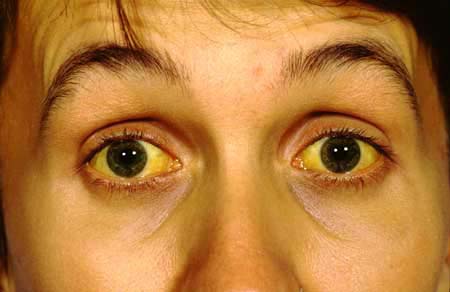 Known as jaundice, yellow skin can happen for several different reasons. Liver disease is the most common reasons for it. A majority of the time, it is from the hepatitis virus, cholangitis or alcohol. Someone can also develop a yellowing of the skin from consuming an abundance of carrot juice or carrots. Jaundice in adults can result from several different medical conditions, some that are quite serious and potentially life-threatening. Any adult who has developed jaundice will need to go through a comprehensive medical exam to find the cause.
Known as jaundice, yellow skin can happen for several different reasons. Liver disease is the most common reasons for it. A majority of the time, it is from the hepatitis virus, cholangitis or alcohol. Someone can also develop a yellowing of the skin from consuming an abundance of carrot juice or carrots. Jaundice in adults can result from several different medical conditions, some that are quite serious and potentially life-threatening. Any adult who has developed jaundice will need to go through a comprehensive medical exam to find the cause.
What Causes Yellow Skin in Adults?
The yellowing of the whites of the eyes and the skin is known as jaundice. It is caused by a buildup in the blood and tissues of the body of a substance called bilirubin. In adults, jaundice is many times indicative of:
- Cirrhosis (living scarring)
- Liver cancer
- Alcohol abuse
- Infections
- Gallstones (cholesterol stones comprised of hardened fat or lipid material or pigment stones comprised of bilirubin)
- Parasites in the liver
- Pancreatic cancer
- Hepatitis (swelling of the liver which lowers its ability to function)
- An adverse reaction to or an overdose of medication like acetaminophen
- Blood disorders like hemolytic anemia (a lowered amount of red blood cells in the body, leading to weakness and fatigue)
Symptoms of Jaundice in Adults Besides Yellow Skin
Jaundice is not a disease, but instead a visible sign of an underlying disease process. Anyone with jaundice will have a yellow discoloration of the skin in different degrees, and could also show yellowing of the mucous membranes of the whites of the eyes. Depending on the underlying cause of the jaundice, however, different people can show different symptoms. Some might have very few symptoms if any at all, while others might experience symptoms that are more pronounced and severe. People with jaundice could experience any of the following symptoms and signs:
- Urine dark in color
- Stools that are pale colored
- Chills and fever
- Nausea and vomiting
- Itchy skin
- Weakness
- Rectal bleeding
- Headache
- Confusion
- Weight loss
- Loss of appetite
- Abdominal pain
- Swelling of the legs
- Swelling and distension of the abdomen
How to Treat Yellow Skin in Adults
Diagnosis
Jaundice is diagnosed by recognizing the patient’s appearance and the symptoms that accompany it. A blood test will confirm that the bilirubin levels are raised, and other tests will be used as well like the ones for hemolysis and hepatitis, which are done on the blood.
An ultrasound is a good way to look at the bile ducts and liver for any signs of obstruction that can many times give useful information on the pancreas gland. CT scanning can also help to diagnose obstructive jaundice accurately.
Treatment
The jaundice treatment will completely depend upon what the underlying cause is. After the diagnosis has been figured out, the right course of treatment can be started. Some patients will need hospitalization, while others could be managed as outpatients at home.
- For some people with jaundice, the treatment consists of supportive care and can be done at home. Most case of mild viral hepatitis, for example, can be managed at home with watchful waiting and your doctor closely monitoring you.
- For patients with alcoholic hepatitis, cirrhosis or acute pancreatitis secondary to alcohol use, alcohol cessation is needed.
- When yellow skin in adults is caused by medications, drugs or toxins, you’ll need to stop use of the offending agent. With cases of unintentional or intentional acetaminophen overdoes, the antidote N-acetyl cysteine might be required.
- Some medications could be used to treat the conditions that lead to jaundice, like steroids for some autoimmune disorders. Some patients with cirrhosis might, for example, need treatment with lactulose and diuretics.
- For infectious causes of jaundice, antibiotics might be needed, or for the complications that go along with particular conditions that lead to jaundice like cholangitis for example.
- For people with anemia from hemolysis or because of bleeding, blood transfusions could be necessary.
- People who have cancer that leads to jaundice will need a consult with an oncologist, and the treatment will vary depending upon the kind and extent of the cancer.
- Some invasive procedures and surgery could be need for particular patients with jaundice. Some patients with gallstones, for example, could need surgery. Others with liver cirrhosis or failure could need a liver transplant.
How to Prevent Yellow Skin in Adults
Jaundice may be prevented by staying away from the underlying cause. These can include:
- Getting vaccinations for hepatitis A and hepatitis B
- Staying away from heavy use of alcohol to stop alcoholic pancreatitis, hepatitis, or cirrhosis
- Taking medication to prevent malaria before going to areas with a high risk of infection
- Staying away from food or water that is potentially contaminated, and keeping up good hygiene to prevent hepatitis A
- Staying away from behaviors that are high-risk such as unprotected sex or drug abuse
- Staying away from toxic medications or substances which could cause hemolysis or liver damage
